
Black Hill, Breacon Beacons, Wales
International travel has been part of my life since our first family trip to Europe when I was 10. The travel bug hit hard and I’ve been doing it ever since. Crossing borders and experiencing different cultures feeds my spirit, fuels my creativity, and just makes me happy.
While I’ve travelled the world including multiple trips to Europe, Cardiff, Wales was never on my radar. With a new 52-page passport since my old one ran out of space for immigration stamps, I was set for an 8-day visit.
SOME HISTORICAL CONTEXT FOR US NON-EUROPEANS…
Wales is part of the United Kingdom of Great Britain and Northern Ireland. While Cardiff’s history spans thousands of years, it’s Europe’s youngest capital city, only having been officially recognized as the capital of Wales in 1955.
As a seaport city, it was because of the docks and abundance of coal that Cardiff was at the epicenter of the Industrial Revolution of the mid-1800s; at one time being the biggest exporter of coal in the world. In 1913, at its peak, more than 13 million tons of coal left Cardiff. The Titanic was using Cardiff coal when it sank. The first million pound deal in the world was struck at the Cardiff Coal Exchange (the coal stock market) and the first photograph of the most millionaires in the world was also taken there. This location is now the recently renovated 5-star Exchange Hotel.
What was once the overcrowded waterfront district known famously and infamously as Tiger Bay is now the modernized Cardiff Bay filled with restaurants, tourist spots, hotels, cafes, the Wales Millennium Centre, and the Cardiff Bay Barrage. Cardiff is the 11th largest and most sustainable city in the United Kingdom, and the 10th most popular international tourist destination.
ADVENTURE DOSED WITH HISTORY AND NATURE…
Always looking to find unique things to do when traveling, my days in Cardiff were filled with a few unexpected surprises.
Museums are not where I’d normally spend time when in a foreign country, but visiting a coal mine sounded too cool to pass up. The Big Pit National Coal Museum, however, was not a normal museum experience where your stroll from room-to-room taking in the exhibition at your leisure; most of it takes place 300-feet underground in what used to be an active coal mine. It’s a full-immersion experience and not for the faint-of-heart. If you’re claustrophobic or afraid of the dark, be warned. I dabble in claustrophobia and had to mentally psych myself up the night before. But trust me, get over it so you can partake – it’s fully worth it.
We geared up with helmets and headlamps before getting into the cage to descend into the abyss; anything with a dry battery (cell phone, car keys, watches) was not allowed in the mine because it could create a spark, AKA, potentially start a fire. The mine is still treated as though it’s active with frequent inspections.
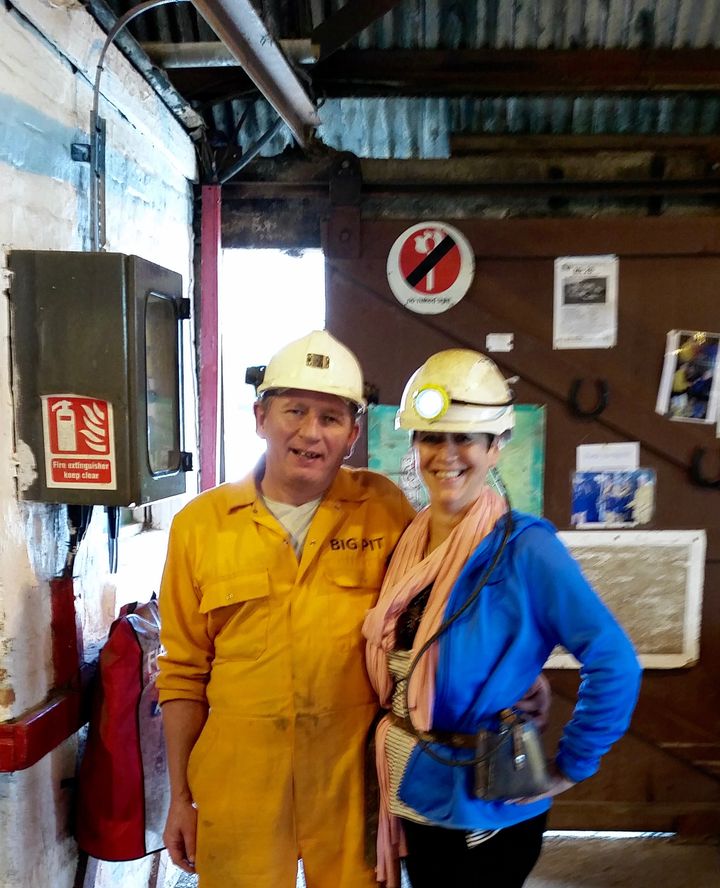
Ready to go into the Big Pit Coal Mine, Wales
We were about 20 people squished into the one cage this mine had to transport workers down. Our guide, a former coal miner, with quick wit, said, ‘everyone cwtch-up.’ There was a simultaneous collective, ‘huh?’ until we realized it meant to cuddle up together even more.
The cage rattled, was dark except for the light from our headlamps, and I was borderline freaking out. Focusing on my breathe and our guide’s jokes helped as we descended about 6.5 feet every two seconds.
The ride seemed endless; when we arrived, we learned that once-upon-a-time not long ago, 1,300 miners worked in this pit. The cage moved much faster when they were working but still, one lift for that many people… gave new meaning to a rush hour commute.
We were only 300 feet down and at 5’6” I was mostly able to stand upright throughout the tour although in some spots I was literally walking bent over at the waist because the ceiling was so low. This was nothing compared to the conditions miners worked in about 2,600 feet in the earth – sometimes in a crawl space just 2.5 feet high, and having to walk 7 miles underground to get to the section of the mine where they’d be working on a particular day.
The experiential aboveground Pithead Bath’s exhibition at this UNESCO World Heritage Site eerily brings you into the lives of the miners, with photos and individual stories on each locker, and a muffled audio looped recording recreating the sounds of showers and conversations.
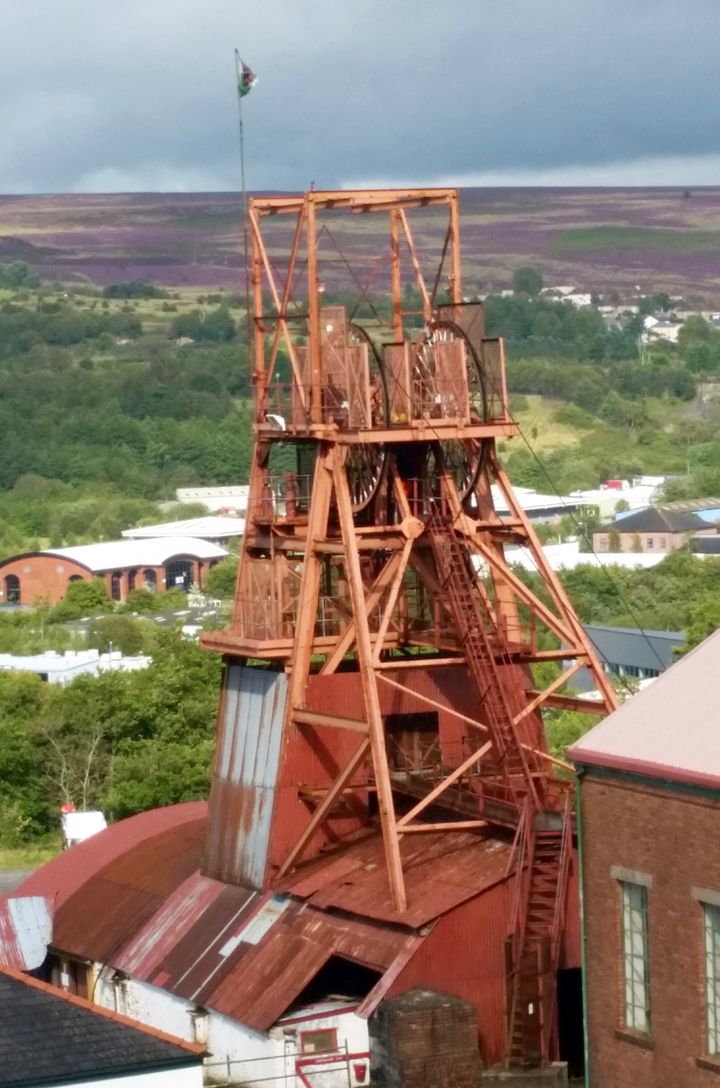
Part of the Big Pit Coal Mine, Wales
Castles are also not usually on my must-visit list, but when were drove by Caerphilly (pronounced car-philly) Castle, its massive, menacing presence and “don’t fuck with Caerphilly!” vibe was so strong that I had to check it out.

Caerphilly Castle, Wales
It’s Wales’ biggest castle and the second biggest in Britain. Hard to imagine that it was built by nobleman ‘Red’ Gilbert de Clare, Lord of Glamorganin in less than three years between 1268 – 1271 given that it took longer to build a high-rise building near where I live in Brooklyn.
With its moats that were once filled with human-eating wildlife, and all sorts of surprise points of attack from almost invisible holes in the side of the castle that fit spears and arrows, the enemy would have been crazy to try to attack this castle, but many did.
Driving through the Welsh countryside just an hour outside of Cardiff was bittersweet; gorgeous nature and vast open space were juxtaposed with the remnants of a boom-gone-bust, like abandoned factory towns in the U.S.
For more than a century, The Rhondda Valleys were the heart of the coalfields, the ‘mining district’ of South Wales. Collieries filled the valley, as did tens of thousands of workers who were either locals or transplants. Pre-Industrial Revolution, the Valley had a population of about 1,500, which grew to 180,000 in peak years, and is now down to about 85,000.
In some areas, there were rows upon rows of drab housing units that all look the same, many with for sale signs. Malvina Reynolds’ song “Little Boxes,” kept coming to mind… “Little boxes on the hillside… Little boxes all the same…”
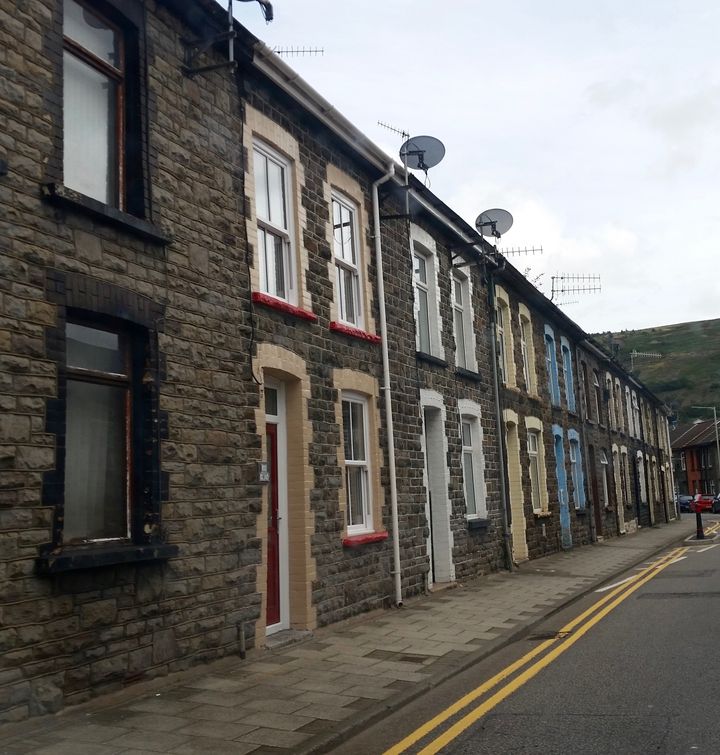
Rhondda Valley, Wales
The once lush rolling hills of the Rhondda Valleys are coming back to life. Although mostly treeless, in certain areas reforestation has begun. Nature is taking over and the remaining patches of coal slag, a reminder of the past, are slowly being covered by the richest of green grass and heather that grows naturally.
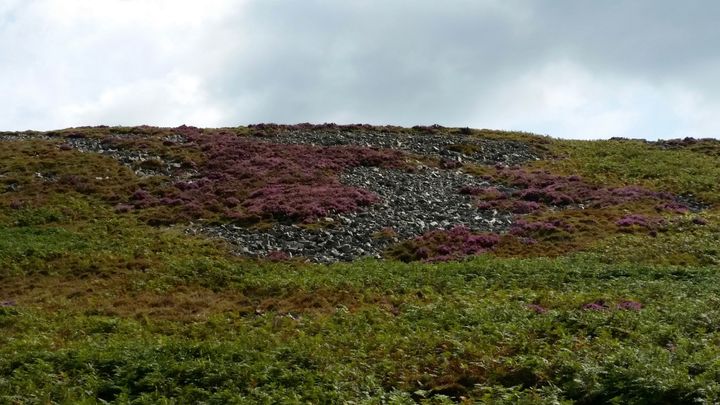
Coal slag being covered by nature, Rhondda Valley, Wales
Oddly, Wales has a lot of sheep. To the 3.1 million people in the country, there are between 10 – 11 million sheep. In the Rhondda, there are four times as many sheep as humans!
In the middle of nowhere, we came upon Llanthony Priory, a remote church that was built by two hermits in 1108. Set against the backdrop of the Black Mountains that were the inspiration for Bruce Chatwin’s book, “On the Black Hill,” and his favorite valley in Wales, the church became one of the earliest houses of Augustinian canons founded in Britain, and one of only a handful in Wales. Now, it’s a great stop to soak in the majesty of this medieval architectural ruin.
In every direction, it’s picture-perfect, inspirational, and impossible to take a bad photo.
Wales continued to be full of fun, odd surprises when we got to Hay-on-Wye, the world’s largest second-hand and antique book center. Every shop except for a few cafes and small restaurants is a bookstore filled to the brim. There are literally piles of books everywhere. If you’re looking for something in particular, good luck, as most stores have not catalogued their inventory. Bring time, patience, and room in your suitcase, or visit in May for the 10-day annual Hay Festival of Literature and Arts which features high-profile speakers and attendees from around the world. Bill Clinton called it, “The Woodstock of the mind.”
Another fun fact is that Wales is filled with ghosts, many of whom love the 900+-year old The Skirrid Mountain Inn, one of the oldest pubs in Wales, and one of Britain’s Most Haunted Pubs.
Unfortunately, it was closed when we were passing through but I learned that the building was once both the courthouse and execution site. Through the window we could see notches in the oak beams where hangings were done.
Located in Brecon Beacons, the Inn, which supposedly inspired Shakespeare, was built on a mountain ‘that once shivered.’ If you’re courageous, book a room for the night and see if any ghosts join you.
MEANWHILE, BACK IN CARDIFF…
I love Cirque du Soleil so it was a no-brainer to book a private rope class at No Fit State Circus, the leading large-scale contemporary circus in the UK where visitors can see a performance or take a class to literally learn the ropes.
While it had seemed like a good idea, it turned out to be quite the reality check that it’s time I start using my gym membership instead of just paying for it, as the upper body strength needed was insane. Circus performers make it seem so simple and effortless, I felt like a hippopotamus. It took almost an hour, sometimes with two instructors simultaneously trying to get me just an inch off the ground. Ultimately, I got my butt up in the air and my head upside down and miraculously didn’t puke on the mat! Fun, humiliating, and yes, I’d do it again.
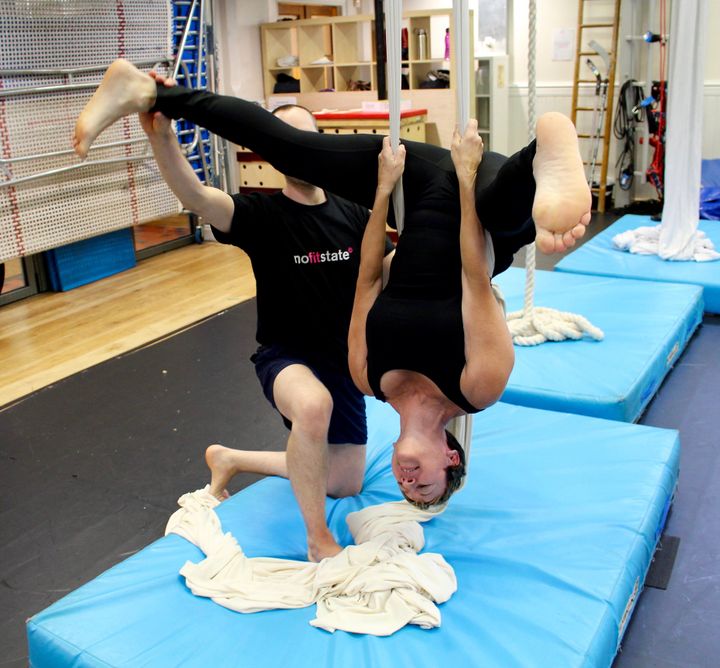
Your’s truly upside down with No Fit State Circus, Cardiff, Wales
To digest the experience, I wandered through Bute Park in the center of Cardiff, just next to Cardiff Castle. With more than 2,000 trees including the massive ‘Champion Trees,’ it’s one of the largest and most beautiful parks in Britain.
Fresh air and exercise meant it was time for the best reward -- lunch at The Clink Restaurant at Cardiff. What looks like a burger shack from the outside is actually a fabulous 5-star restaurant run by inmates. Named 10th Best Restaurant in the U.K., prisoners are working toward employment in the hospitality industry upon release. My waiter, a lovely young man just turning 30, was finishing his 5-year sentence in a few days and starting a hospitality job at one of the major restaurants in Cardiff Bay.
Since opening in 2009, the Clink has won more than 50 awards. Run by the Clink Charity, its mission is to reduce recidivism by training prisoners and placing them in employment industry jobs upon their release. More than 800 prisoners have graduated from the Clink programs, with a success rate to date of a 41% reduction in reoffending.
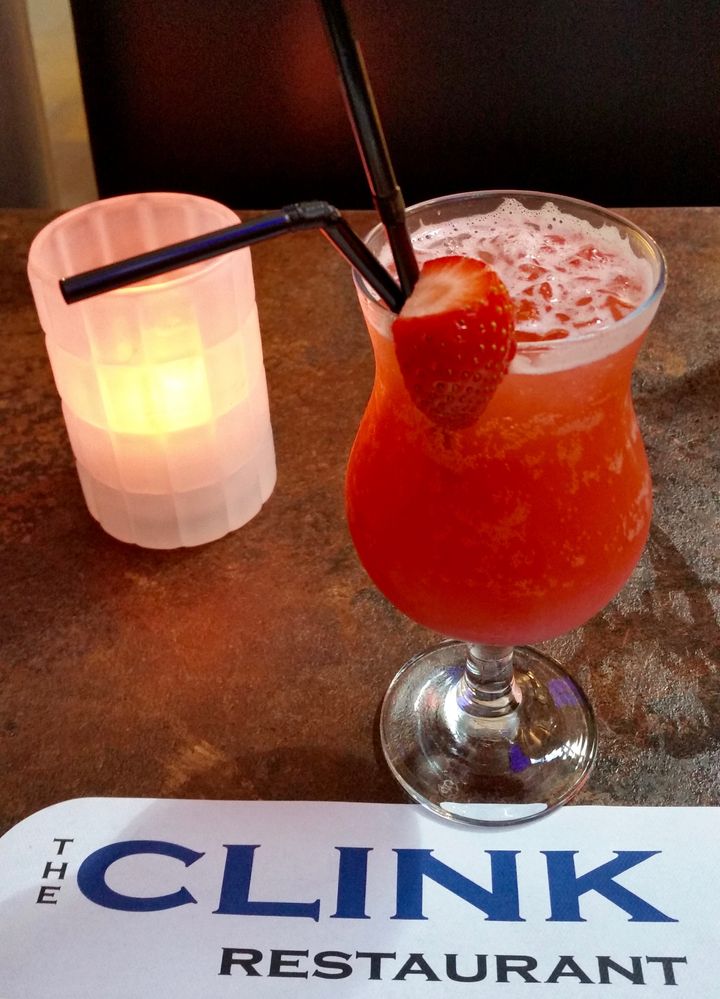
Lunch prepared and served by inmates, The Clink Restaurant, Cardiff, Wales

THE UNEXPECTED…
From being an unfamiliar destination, to one that has now tattooed a couple of my most unique all-time travel experiences (and I’ve done some crazy, incredible things travelling); this trip was the just appetizer. Eight days is never enough time in a new country, but it expanded my perspective and left me hungry to return to Cardiff.
Comments, shares, and likes are welcome!
Susan Jacobs is a writer, storyteller, strategist, and world traveler. She contributed a chapter to the book “Pain, Purpose, Passion: That Was Then, This is Now,” and has a book publishing deal with The Round House Press for whom she is working on her first memoir. She is a contributing blogger for Huffington Post, Yogic Living, Thrive Global, and Identity Magazine, and her writing has appeared in FourTwoNine Magazine, Aquarian Times, Spirituality & Health, PR Week, and IndieWire.
Giving voice to things that matter, spreading ideas, and expanding perspectives is the heart and soul of who she is and what she does.
www.bluezanconsulting.com | Follow Susan Jacobs on Twitter at @susanjwrites
